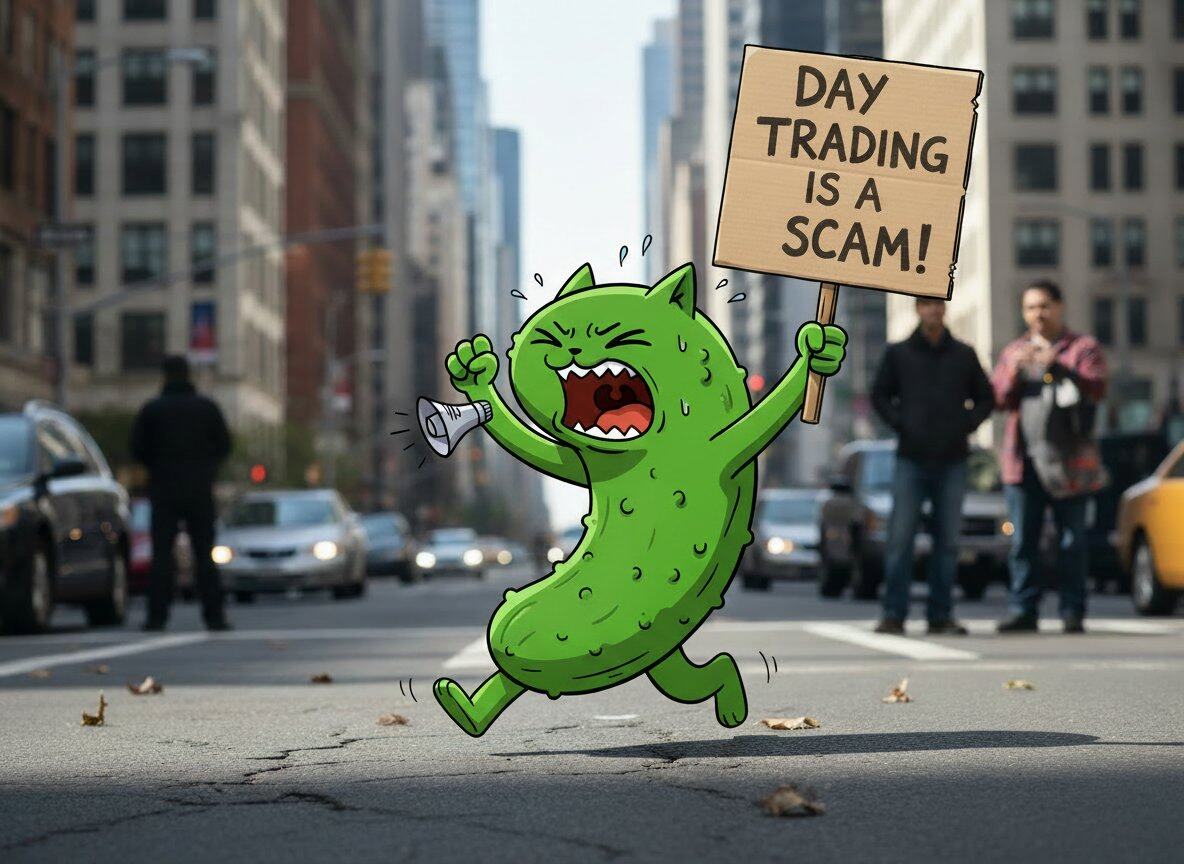Comprehensive interpretation of Web3 domain names: application scenarios, track conditions, and future challenges
Original Author: Chuan Lin
preface
Original Author: Chuan Lin
first level title
preface
When you hear that a certain Web3 domain name has been sold for a sky-high price, when you see a Web3 friend around you change to a domain name as his user name, when you start to look for the domain name you are interested in in the registration column Do you think deeply about the usefulness of these domain names? What are the differences and connections between different projects? What is the imaginative space for the development of the domain name track? If you are interested in these issues, please don't miss this article!
The structure and core viewpoints of this article are as follows. Readers who already know about Web3 domain names can jump directly to the chapters they are interested in for reading:
Chapter 2, the application scenario of Web3 domain name: Unify the account name and identity data in the application, interconnect with the Web2 web page address, and use itself as an identity management and social display tool
Chapter 3, Classification of the Web3 domain name track: single-chain domain names (including public chain domain names, multi-domain name registrars, and social domain names), multi-chain domain names (including three different implementation paths), DNS alternative domain names
Chapter 4, the author’s observations on Web3 domain names, including: the strength of user demand for Web3 domain names, the analysis of Web3 domain name transactions, the prospect of the competition pattern of Web3 domain names, and the potential suffix conflicts of Web3 domain name projects
first level title
#Chapter 1: What is a Web3 domain name?
The concept of a domain name originated in the early Internet era. In the earliest days, everyone directly accessed the web page through the IP address. For example, if you enter "202.108. Baidu's IP address. But obviously, this string of numbers is not readable and difficult to remember. Therefore, the early Internet designers built the Domain Name System DNS (Domain Name System), which encapsulates digital IP addresses by using more readable domain names such as www.baidu.com as "web address", so that People use it every day. Now, every Internet user knows the concept of "web page address", even if most of them don't know the underlying IP address, DNS and other principles, but this does not hinder their experience on the Internet at all.

The most intuitive value of the Web3 domain name is also similar. It is the user's "Web3 nickname", which is the encapsulation of the address on the chain. For example, vitalik.eth is the encapsulation of the Ethereum address "0xd8da6bf26964af9d7eed9e03e53415d37aa96045". Every Web3 user will hold at least one address on the chain, but I am afraid that no one will think about remembering their own addresses, let alone remembering others. Domain names such as vitalik.eth, 2089.bit, and jack.bnb are obviously more readable and memorable than the long string of address characters, and can better meet people's daily needs. For example, if you need to ask your friend to transfer money to you, you may find your on-chain address in your wallet or notepad, and then send it to your friend; but if you hold a domain name, such as vincent.eth, you can Directly tell your friends to transfer funds to this domain name.
From this point of view alone, the value of the domain name has a lot of room for development: after all, it can help the public users to shield the technical details of the address on the chain, so will it become the address when Web3 enters the public? The "agent" in the user's mind is like the majority of users on the Web who "only know the web page address, but not the IP"?
Web2 domain names and Web3 domain names
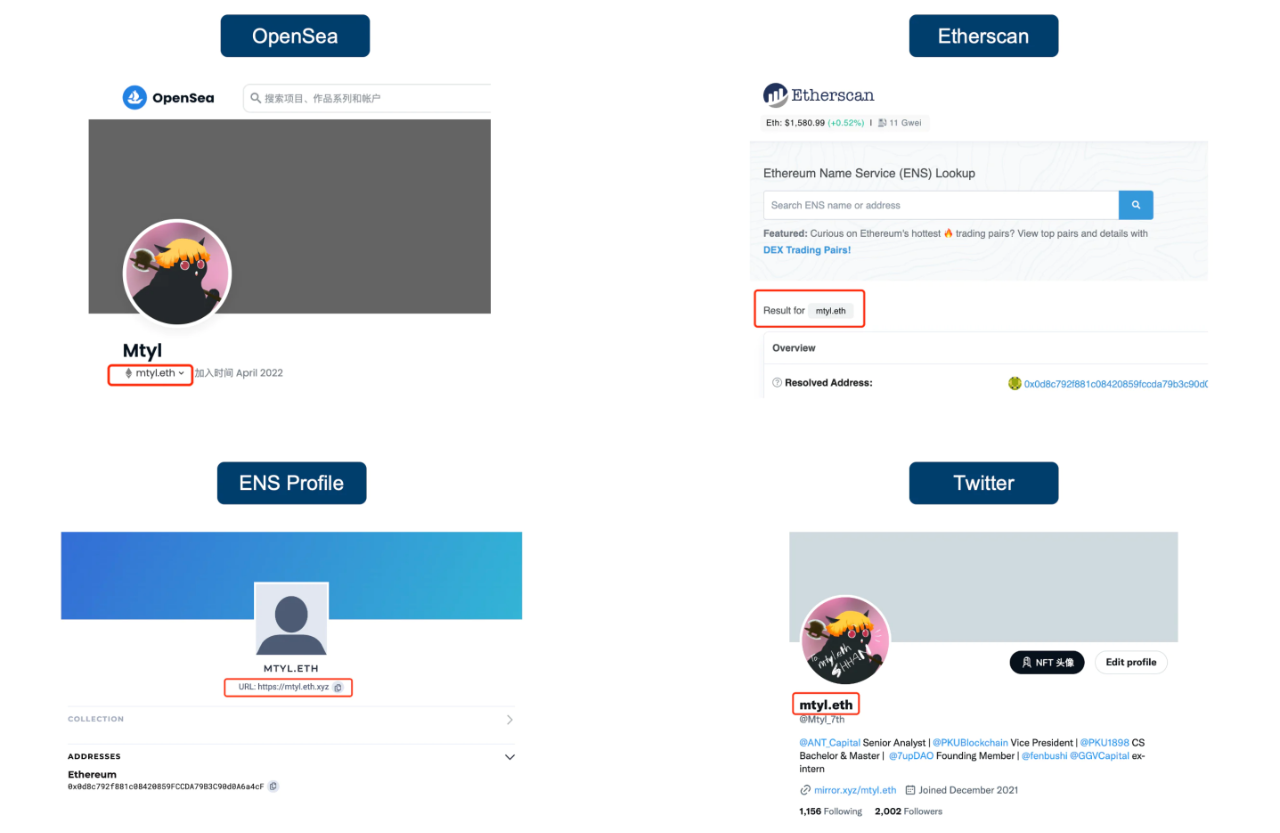
In addition, in addition to binding the address of the public chain, the domain name has more room for imagination, because it can also be bound to other public chain addresses, Web2 accounts, and even Web2 DNS addresses. For example, you only need to know the ENS domain name "mtyl.eth", and you can directly find one of the author's commonly used Ethereum addresses, its corresponding Opensea account, the author's Twitter account, and the author's personal homepage website in ENS. To some extent, this is the prototype of a Web3 universal identity that has emerged.
image description
first level title
#Chapter Two: Specific Application Scenarios of Web3 Domain Names
As an NFT product sold directly to users, what is the use of a Web3 domain name? Next, let the author sort out the application scenarios of domain names in Web3 in detail.
secondary title
2.1 Domain name + DApp: unification of account names and data exchange
In Web3, due to wallet address login and chain resolution of domain names, DApp can easily support users to use a certain domain name as their account name. And because of the uniqueness of the domain name, as the domain name's support for multiple chains matures, you can ensure that the same person using the same domain name on Opensea (ETH) and Magic Eden (Solana) is the same person. Even Web2 applications such as Twitter can use some plug-ins to authenticate those who use their own NFT domain names as their usernames. It is not even ruled out that platform giants such as Twitter will support similar functions in the future.
Behind the unification of account names is the exchange of identity data. Since the domain name resolution information contains information from other chains and Web2, the application side can obtain user information that cannot be obtained only through the wallet address on the chain through the domain name. This not only directly imports user data, but also reduces the cost for users to get started with new applications from the information level (think about filling in various information of Web2 applications), and also enables the application side to make targeted recommendations to users; Credentials and badges can also be resolved and bound by domain names, increasing the interoperability on the chain and user recognition.
Although this cross-chain and cross-Web2 intercommunication of identity data does not necessarily have to be realized through domain names, domain names are indeed a natural and excellent carrier for users, and they are strong competitors and partners for this segmented value point.
secondary title
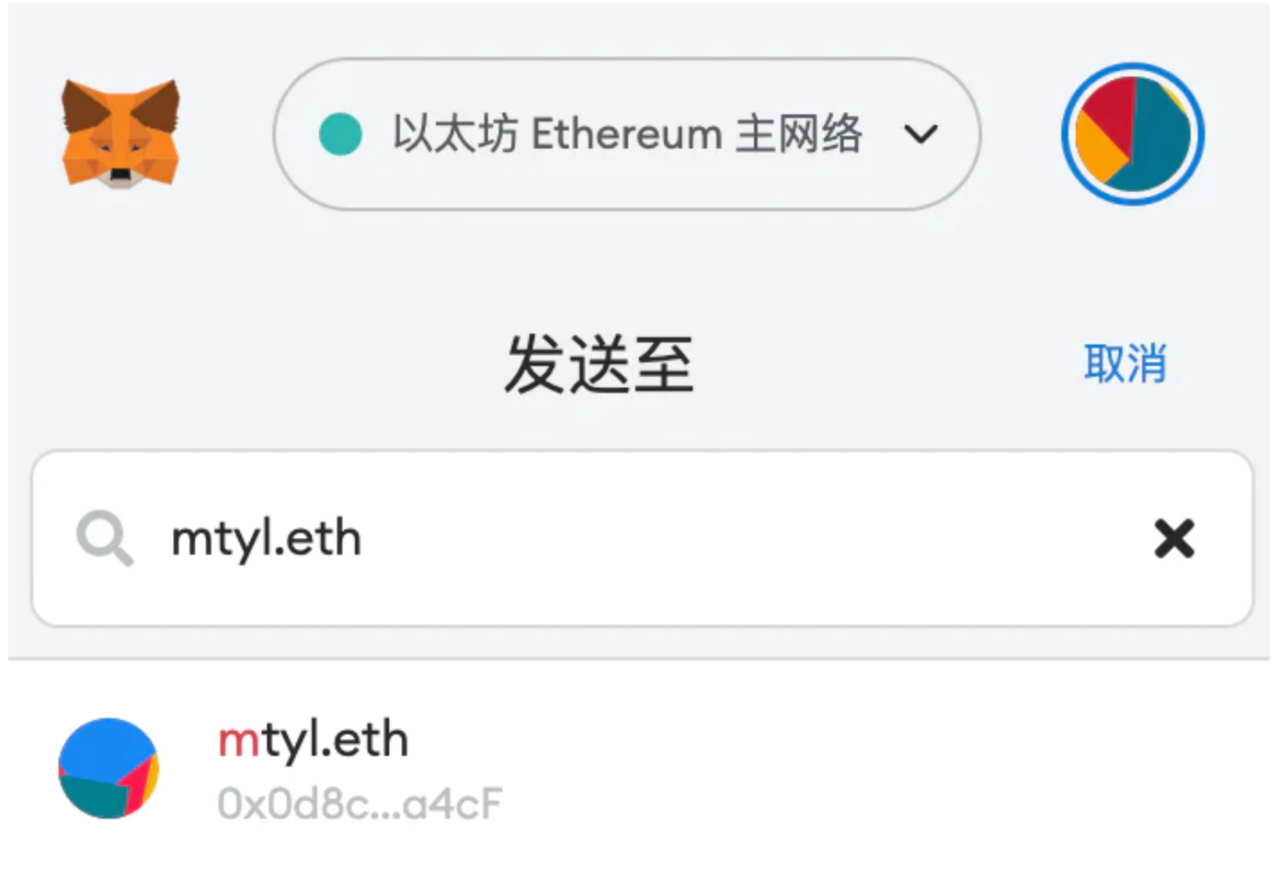
2.2 Domain name + wallet: search address through domain name, unify account address management
The most common cooperation between wallets and domain names is to support domain name searches during transfers, which saves users from remembering transfer addresses. For example, Metamask, a leading wallet product, has already implemented ENS domain name search support.
No need to display a long list of addresses, no WeChat payment code, just remember a simple domain name to support the author
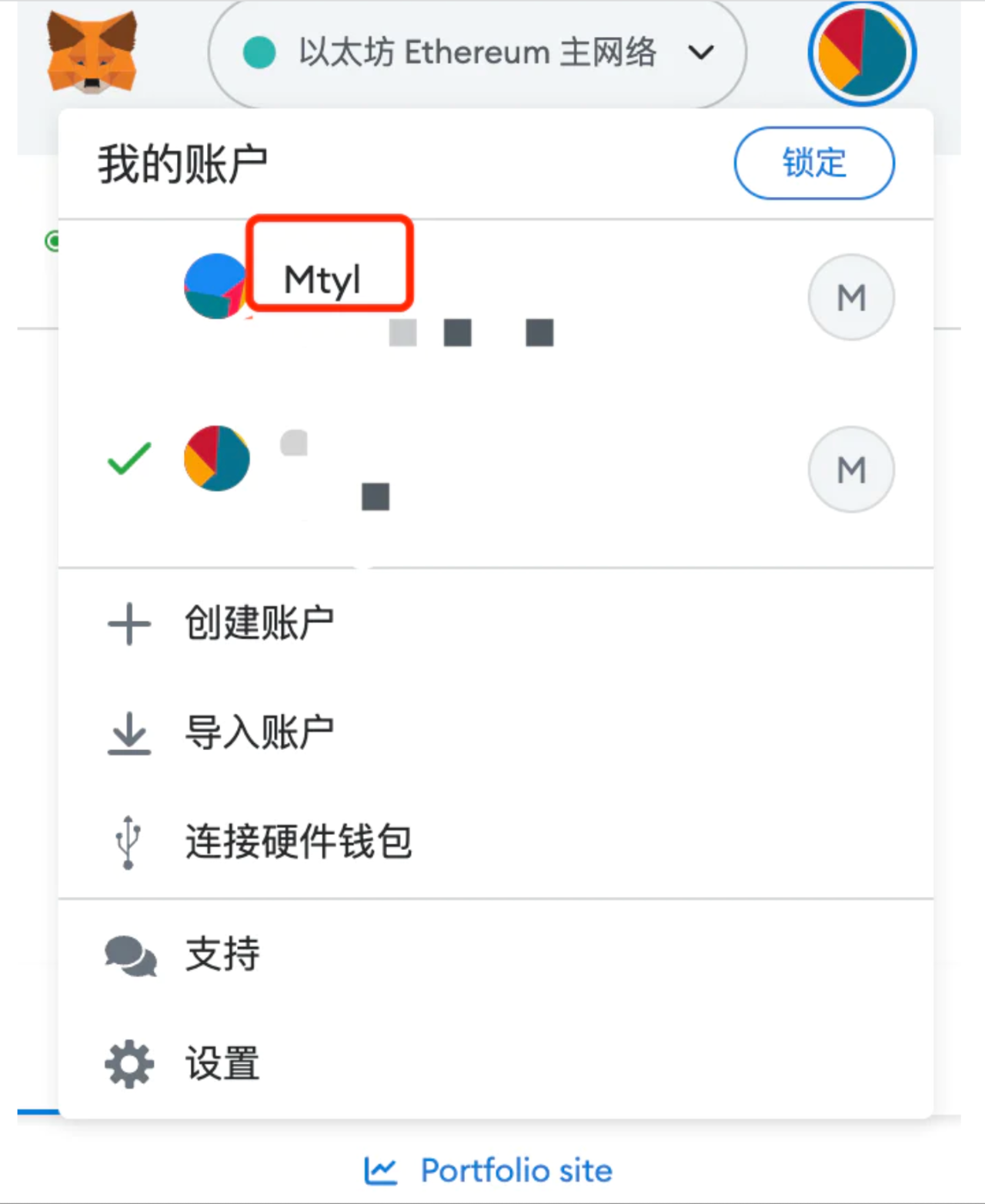
There is room for deeper cooperation between wallets and domain names, but these cooperations may involve the strategic development of wallets, so they may not advance quickly.
Still taking Metamask as an example, each Metamask account of the user can create different sub-accounts; and different sub-accounts have different addresses on different chains. The sub-account management is in the upper right corner of the browser plug-in, as shown in the lock picture below:
In fact, the sub-account name and the corresponding ecological niche can be replaced by domain names
The account name of Metamask can be freely set by users at present, and it does not have any application scenarios (simple user management is convenient). But in fact, this account name can cooperate with the domain name project party to use the corresponding domain name. The addresses of each public chain bound to the domain name naturally become the interaction address of the wallet and the application.
Further derivation, after the wallet integrates the domain name and its various resolution relationships, it can also be displayed in the wallet. For example, it displays the relationship between Twitter, Reddit and other Web2 social platforms corresponding to a domain name account, and the credentials held by users in various DApps. These things are actually what some DID-focused wallet project parties themselves want to do, which makes this kind of cooperation a potential conflict of interest. In addition, it is not easy for the domain name project party to make these tool protocols, so there is no practical progress yet. But in the future, this is indeed a possibility.
secondary title
2.3 Domain name + Web2: intercommunication of web page addresses
In ICANN's Web2 domain name management system, "webpage suffixes" such as ".com", ".cn", ".xyz", ".link" are called "top-level domains", and applications for new top-level domain names, Special submission + auction required. This not only requires a lot of application fees, but also the opening of the domain name and the auction time are completely determined by ICANN. In addition, ICANN has a brand protection rule-if a brand owner (such as Apple) finds that its trademark domain name has been registered, it can appeal to obtain its own domain name. Many potential troubles. In addition, ICANN will reserve top-level domains for countries (such as .cn is for China), and the suffixes of a few projects conflict with country abbreviations, such as ".eth" of ENS and ICANN reserved for Ethiopia (Ethiopia) ccTLD conflicts.

Although "vitalik.eth" cannot be directly input into the browser to be parsed, such as "vitalik.eth.xyz" and "vitalik.eth.link" can be. Readers may wish to give it a try. For example, enter "vitalik.eth.xyz" in the browser to see the ENS Profile generated by Vitalik by default; enter "vitalik.eth.link" to see Vitalik's personal homepage:
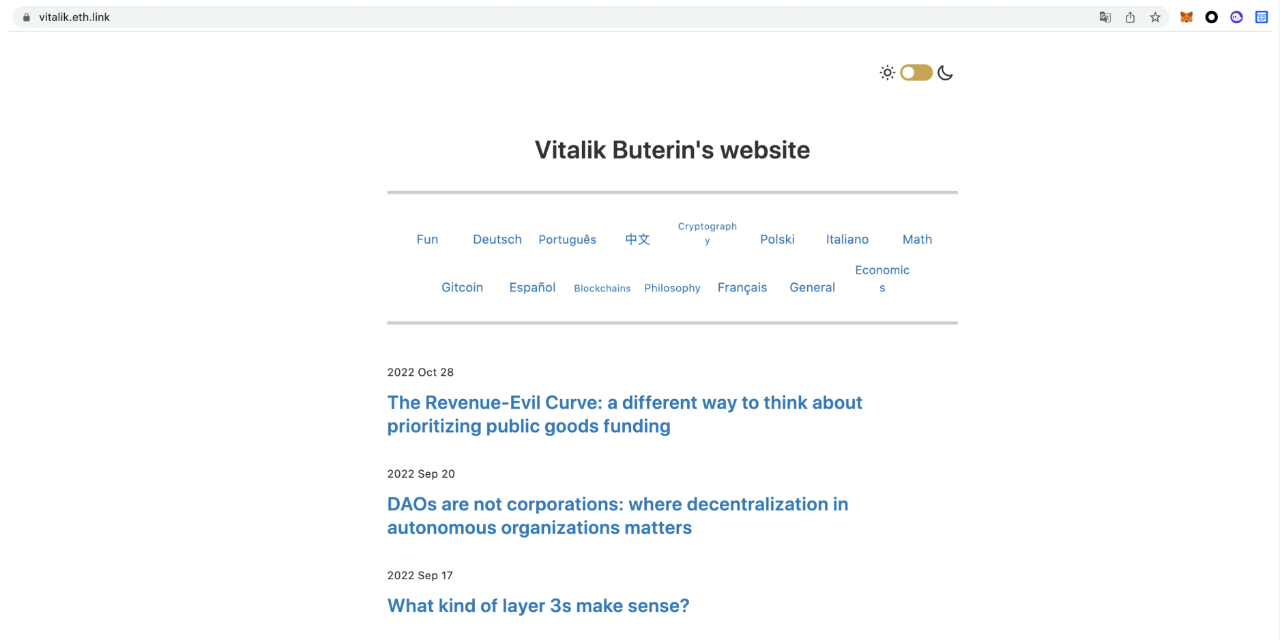
image description
Vitalik's ENS Profile
Vitalik's personal homepage built on eth.link
What top-level domain name to use specifically, what is the meaning of each top-level domain suffix, and even whether the project party can obtain control of the corresponding domain name, there is no convention. Taking ENS as an example, .eth.link was previously registered by co-founder Virgil Griffith, but due to Virgil’s imprisonment, the domain name was auctioned to Manifold Finance after it expired. ENS has filed a lawsuit in court, hoping to regain control of the domain name, and the case is still pending.
This kind of direct connection with the web page address, although its specific implementation still relies on the Web2 domain name system, requires the project party to be able to obtain the control of the second-level domain name it is interested in, but this is compared with some other solutions (such as IPFS static resolution + Web3 browser opening), it is more acceptable to the public. This natural interoperability with Web2 websites is also a unique feature of Web3 domain names, compared to other similar identity management carriers.
secondary title
2.4 Domain Name Application Ontology: Identity Management Tool & Social Display Homepage
The ontology of the Web3 domain name application is now mostly responsible for the functions of registering domain names and binding addresses on the main chain, and its presence is not high. However, as more and more applications and wallets support domain names with applications, wallets, and Web2, domain name application ontology will also carry more identity management functions. Specific examples are as follows: set the analysis targets corresponding to each chain and each Web2 platform, set the address, format and display information of the personal homepage, set some private content/content that requires specific permissions to access, etc.
For example, the second-level domain name suffix .eth.xyz carries the function of the ENS personal homepage. As long as you know any ENS domain name, you can add .xyz after it and enter the browser to see the corresponding address of the domain name owner. some display information. Although the experience of this demonstration is still very rudimentary, it is indeed established in the long run. In addition to being operated by the domain name project itself, the personal homepage can also be carried out in cooperation with link3 and other projects that want to do similar things.
If you use your imagination further, the domain name project can also do social networking by itself, or social networking can also be one of the core operations of the project by issuing domain names. The SNS domain name issued by Linkkey is one of the more practical projects of this type.
If readers are interested in the decentralized identity track, you can refer to the author's previous research on DID:
2.5 Summary of this chapter
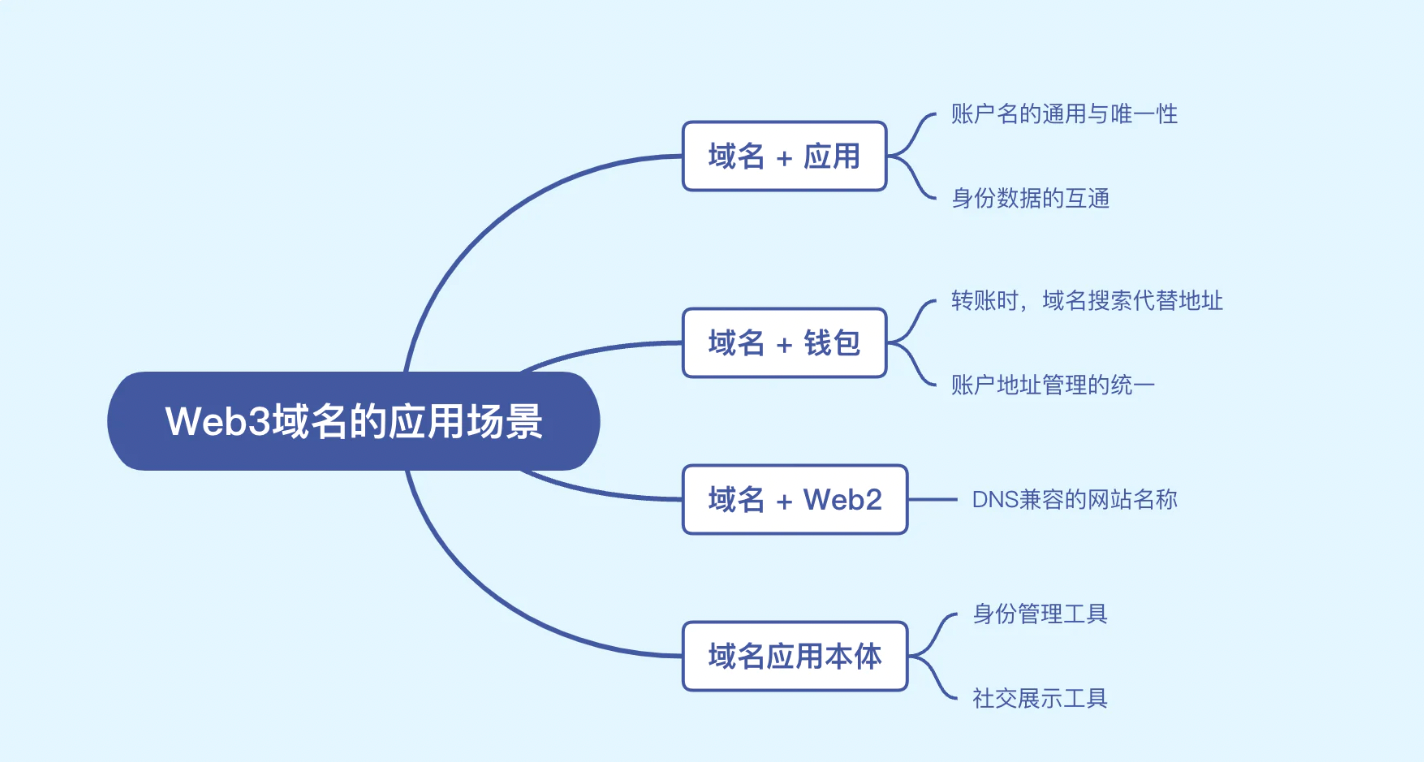
The above is the author's integration of the more practical application scenarios of the current Web3 domain name. Different domain name projects have different emphasis on development.
In the third chapter, this article will classify and sort out the main projects of the Web3 domain name track, so that readers can understand the differences and connections between these projects, as well as the specific data and implementation details of the domain name project.
first level title
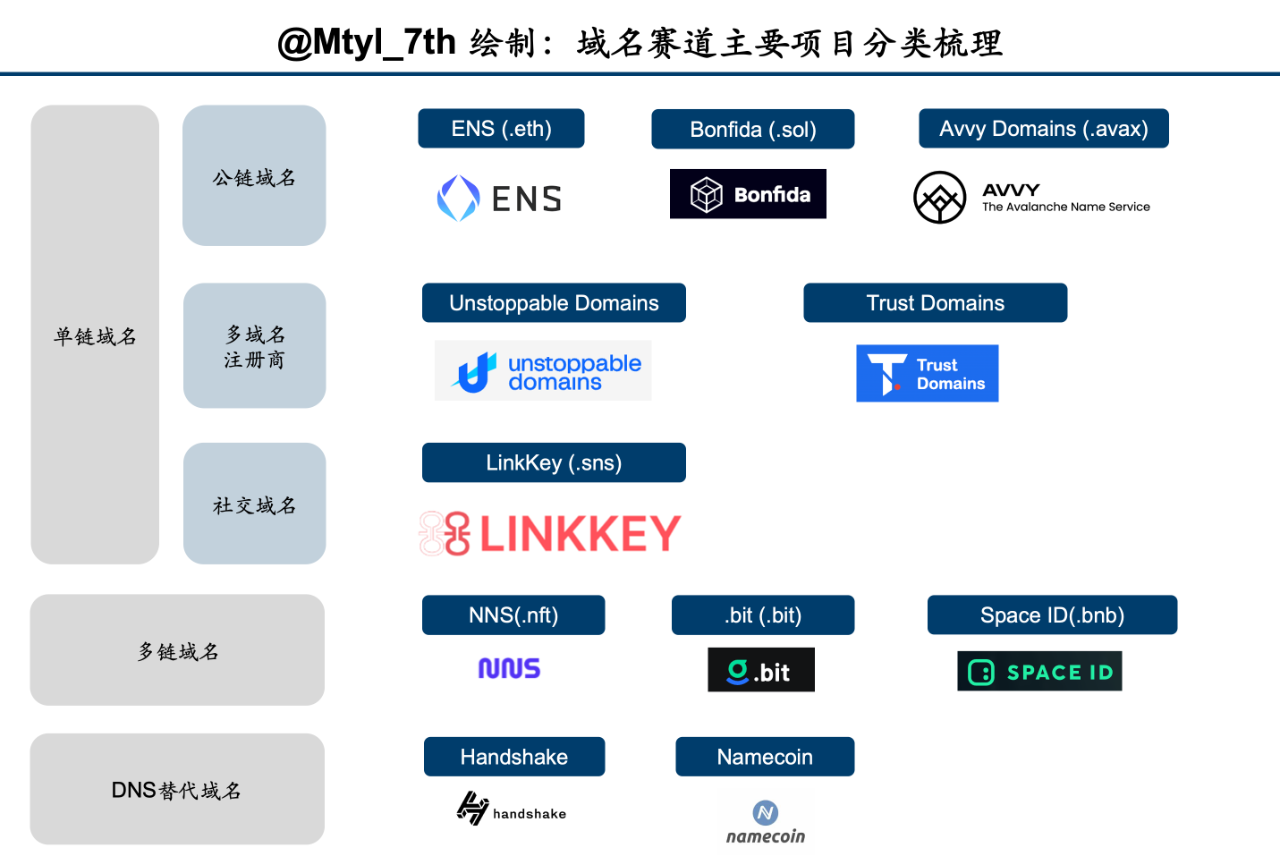
#Chapter Three: Classification of Domain Name Projects
There are currently many domain name projects, there may be nearly 40 or 50, but it is not too complicated in terms of technical implementation and application scenarios. You can regard ENS as the "pioneer" and "big brother" in the field of domain names. Most of the domain name projects are replicas of ENS on different public chains. Even if they are not direct replicas, their specific implementation on the chain also highly refers to ENS.
The author divides the current domain name projects into the following three categories: single-chain domain names, multi-chain domain names, and DNS alternative domain names. Among them, single-chain domain names can be further refined. As shown below:
3.1 Single chain domain name
3.1.1 Public chain domain names: represented by ENS
ENS is the leading project in the field of Web3 domain names. It was founded in 2016 by Nick Johnson, a former software engineer at Google. Initially, ENS was a sideline project authorized by the ETH Foundation, and then the ENS team was established with the support of the ETH Foundation. ENS has not received any external financing, and has only accepted donations from institutions such as the Ethereum Foundation.

ENS launched the beta version in May 2017 and the official version in May 2019. The trading volume of ENS ranks in the top ten of Opensea all year round, and there will be two peak trading periods in November 2021 and April-May in 2022. As of the beginning of November 2022, ENS has registered 2.62 million domain names, 573,000 registered users, and 508 ecological cooperation projects. These data are far ahead of many other similar projects. ENS will be airdropped + issued in November 2021. At the beginning of November 2022, its fully diluted market value will be about 1.5 billion US dollars.
ENS currently has no plans to directly expand to other public chains. The recent actions of the project party are mainly reflected in the connectivity of Web2 web pages, such as the second-level domain name web pages and their corresponding applications mentioned above. In addition, ENS is also working with Spruce ID to promote the new login method of Sign-in with Ethereum (EIP -4361), hoping to realize the connection of identity data through it, which is very worthy of attention and expectation.
image description
While ENS and visibility are great, it's not flawless. ENS exposed the "ZWJ character problem" after it went online:
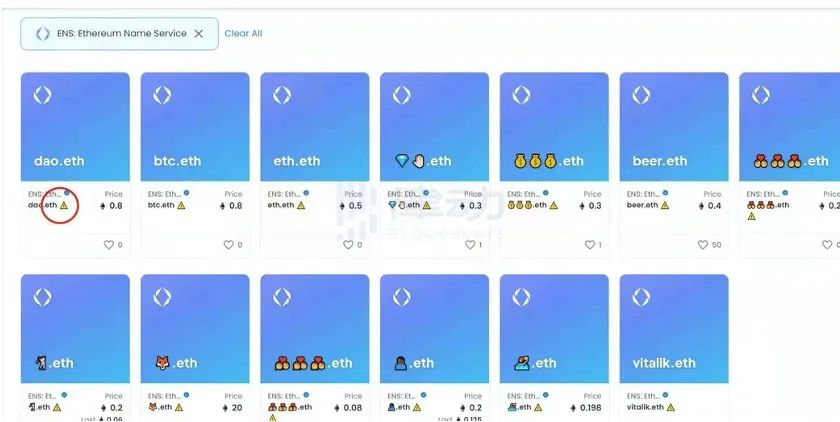
The ZWJ problem refers to the fact that ENS supports padding characters ZWJ - such as "%E2%80%8D" when registering, so that domain names that are substantially different can be presented with the same appearance. For example, "vitalik%E2%80%8D.eth" and "vitalik%E2%80%8D%E2%80%8D.eth" are displayed on the webpage as "vitalik.eth", which makes it difficult for users to copy and paste There is a risk of being deceived by "fake domain name" to realize the transfer by means of domain name.
At present, this problem cannot be solved by ENS technically. It can only be patched by the application layer consciously. For example, Opensea and Metamask will put yellow exclamation marks on domain names with ZWJ characters. However, if ENS enters a large-scale promotion period, it can be predicted that related fraudulent applications will inevitably appear. This has buried potential troublesome factors for the large-scale promotion of ENS.
image description
Opensea's "yellow triangle" ENS domain name
Such projects often sell Web3 domain names with multiple suffixes at the same time, and these domain name suffixes are often highly related to Web3. Representative among them are Unstoppable Domains.
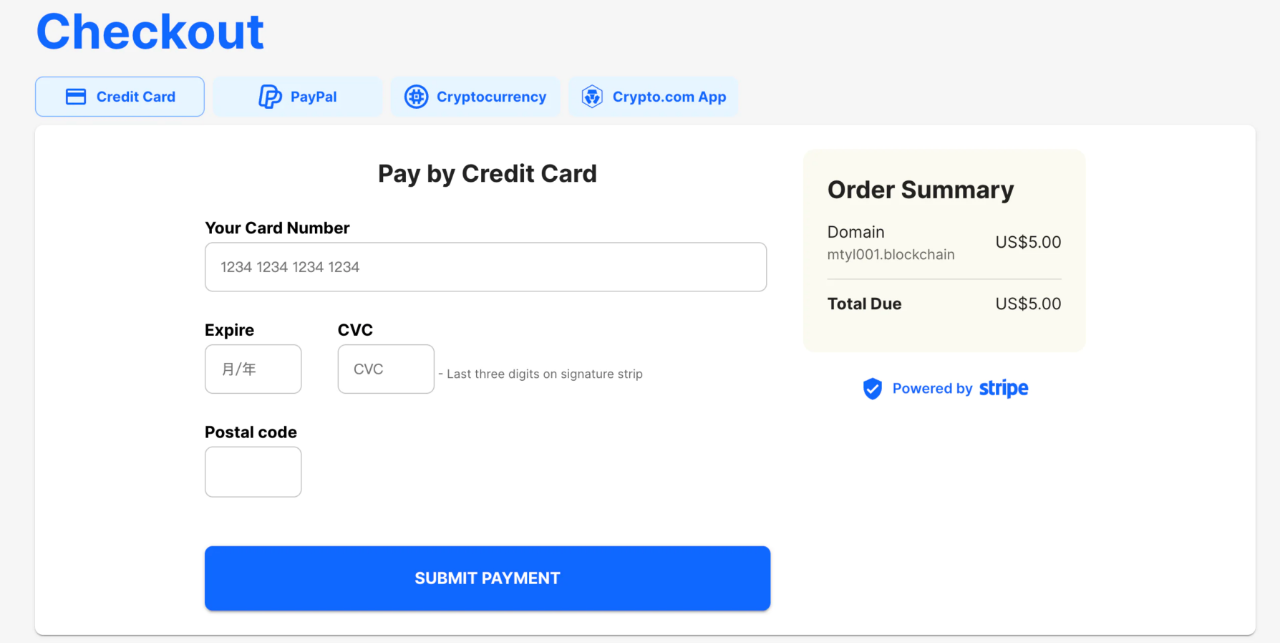
The registration process of Unstoppble Domains is not completely on-chain like ENS and other projects, but a model of centralized registration management + NFT mint on the chain: users can log in with Google + credit card payment when registering, and then go to Polygon mint NFT (except for .zil domain names, go to mint on Zilliqa).

image description
Unstoppable Domains can pay by credit card when registering
image description
After registration and payment are completed, go to the chain of mint
In terms of project development, Unstoppable Domains will also focus on the concept of "Web3 name", but its actual product design and publicity focus more on the experience of Web2 users, as well as the interoperability between its domain name and Web2 website. In terms of Web3 connectivity, in addition to the previously mentioned account name cooperation, Unstoppable Domains also launched "Login with Unstoppable", which is a button that is parallel to wallet login methods such as "Metamsk" after you click "Connect Wallet" , users can use this method to log in in cooperative projects such as yearn.finance. However, this kind of login cannot bypass the wallet at present, but requires an additional process of filling in the domain name, and the current user experience is not good.
Unstoppable Domains may not be particularly well-known in the Chinese circle, but its popularity overseas and its overseas marketing efforts are very strong. At present, the number of domain names registered by Unstoppable Domains has exceeded 2.7 million, and more than 500 applications have integrated Unstoppable Domains.
3.1.3 Social Domain Name Application: Represented by Linkkey
Such projects may not have special innovations in domain name technology, but they focus more on combining domain names with social applications.
Linkkey's SNS is one of the representatives, and it hopes to use the domain name as the carrier to do "value social networking" in the Web3 field. According to the theory that "one person can only maintain deep social links with 150 people at the same time", each SNS user can issue NFTs that symbolize their own social value, and the user's social value is determined by the market price. Linkkey’s token model design is also innovative. Its domain name registration function and some product functions have been launched. The complete product will be available at the end of this year and early next year. Interested friends can go to its official website to experience and learn more.
secondary title
3.2.1 .bit
3.2 Multi-chain domain names
NNS, .bit, and Space ID are the three main projects in this category. In the promotion and development of the project, they all emphasize the nature of "Web3 identity business card" and "Web3 identity management", and have written a clear multi-chain support plan.
However, on the issue of how to implement "multi-chain support", the solutions of the three domain names have their own characteristics. In the following, the author focuses on a brief introduction of their multi-chain implementation scheme.
The .bit project team has launched a domain name system with the suffix .bit. The project team believes that the development of .eth, .bnb, .sol and other public chain suffix domain names may encounter some upper limit problems (especially new public chain domain names), because the core projects on other mainstream L1 public chains may be unacceptable and The domain name with the suffix of another public chain is used for cooperation. .bit is just a domain name suffix without a public chain label, which may have more natural advantages when conducting multi-public chain cooperation.
.bit is implemented based on the Nervous CKB public chain. This public chain cannot be regarded as a mainstream public chain in the public perception, but it has a unique nature - it is specially built to realize the unified management of different public chain assets of.
3.2.2 NNS
How to implement multi-chain asset management for Nervous assets involves some technical issues of cryptography principles. There is a relatively intuitive metaphor in its official document, which is briefly described as follows:
If the ETH public chain and the BTC public chain are compared to the United States and the United Kingdom, respectively, and the ETH address and BTC address are compared to the ID cards of the United States and the United Kingdom, the current status is that residents must have an American ID card (BTC address) to be in the United States ( BTC) holds and manages assets, as does the UK (ETH). The two countries do not recognize each other's national identity card (address).
The Nervous public chain can be regarded as a neutral and open third country, which supports citizens of other countries to hold assets through ID cards of other countries. For example, if a BTC user sends assets issued on Nervos CKB in the BTC wallet, it can be regarded as Sell TA's house in a neutral country for US residents holding a US ID card, and this process has been officially recognized by the neutral country (verified by the Nervos CKB node).
3.2.3 Space ID
NNS is a domain name system with the suffix .nft launched by the Metascan.pro (Twitterscan’s parent company) project. Currently, it mainly implements core functions such as registration and resolution on the Ethereum main chain.
The Metascan project team will launch the NNS contract on other public chains (such as BSC) in the next few weeks, so that users can register and manage domain names with lower GAS fees. The NNS domain name systems on different public chains are unified. The specific realization of this "unification" may involve the deployment of some information cross-chain nodes, and may also involve some forms of centralized management.
Theoretically speaking, cross-chain domain names are not complicated, as long as the domain name resolution information on all chains can be unified through cross-chain nodes. But in fact, when multiple public chains are involved at the same time, maintaining the synchronization and real-time consistency of domain name registry information still faces many challenges under the current Web3 infrastructure. This is why most domain name projects currently only support one public chain. How NNS realizes this kind of cross-chain, its stability and degree of decentralization are worthy of attention.
This namespace can be roughly understood as follows: if a person holds Solo.bnb on BSC, then in the namespace of Space ID, he will hold bnb:solo in the future; if he holds Solo.eth, then in the namespace Even the account names of Apple and Google can be converted into forms like apple:solo, google:solo, etc.
This vision is worth paying attention to and looking forward to, but the part of Space ID that is already online still has a certain gap with this vision, and it may take longer iterations.
In summary, although most Web3 domain names regard identity management as a core narrative, once multi-chain smart contract domain names are involved, they will face more complex technical details in cross-chain and multi-chain. At present, .bit's multi-chain solution is the fastest in terms of implementation.
3.3 DNS domain name replacement: Handshake, Namecoin
Since their concepts, development directions and most Web3 domain names are very different, and they have not attracted too much market attention recently, this article will not focus on the introduction. Interested readers can do in-depth understanding on their own.
first level title
#Chapter 4: Reflections on key issues of Web3 domain names
secondary title
4.1 Analysis of user demand for Web3 domain names: currently not rigid demand; transactions are mainly concentrated in short digital domain names
Although the author introduced the current application scenarios and uses of domain names in detail before, it has to be admitted that domain names are not just needed by current Web3 users.
The author once made a statistics on the renewal/retention of ENS users through the data on the chain, and found an interesting conclusion: 52% of the active domain names on August 20, 2021 and before August 20, 22 failed. This means that during the year, 52% of the domain names expired (probably registered more years ago), and the original users did not renew, and no new users registered the same domain name in time. Taking the other 21 years for observation, the failure rate is basically between 45-55%.
Considering that the minimum registration period for ENS is one year, although this caliber can only show the situation of old ENS users who registered before November last year, it can also explain a lot of problems. Compared with many "outlet-type" application projects that are fleeting in the Web3 field, this retention situation can be said to be quite good, and it can also reflect the nature of domain names as Web3 infrastructure and long-term growth with the development of the Web3 ecosystem; but from its absolute figures Looking at it, this ratio is still not high, indicating that Web3 domain names still cannot be regarded as the rigid needs of users.
The author believes that the long-term development of the domain name project mainly depends on the development of the Web3 application ecology, especially the development of Web3 social projects. Because it is difficult to bring a fundamental large-scale increase to the entire field only by the domain name project itself in the promotion of application and wallet account names; only the vigorous development of application projects can highlight the account name system associated with the domain name , The importance of the identity management system, highlighting the value of the domain name itself. However, before that, the domain name project must make sufficient preparations, so as not to find that its core functions such as identity management, cross-chain solutions, and Web2 URL connectivity are still not mature enough when the real application wave hits. In addition, it is also a possible development path for the domain name project to end up as a social application or a login system similar to a wallet.
secondary title
4.2 Analysis of Web3 Domain Name Transactions: Currently Focusing on Short Numeric Domain Names
ENS is the domain name project with the most active transactions and fully disclosed data, so its transactions are very representative.
In the ENS domain name transactions in the past three months from April 25 to July 7, 2022, purely digital domain name transactions contributed 44% of the transaction volume, accounting for 65% in terms of transaction volume; In a subdivision, 97% of the transactions are 3-5-digit short domain names, and 3-digit domain names account for 29% of the transaction volume with 1% of the transaction volume. (Source: https://w3hitchhiker.mirror.xyz/-hgyPi_y_Hy9f8PEBNts3yc4EFNT4b5GKhSedM4qOzs)
Judging from the development of various new domain name projects, short digital domain names are similar to 982.eth, 2089.eth, 12346.eth, etc. What is the value of it, and it deserves everyone's concentrated attention and transactions? I think there are two main reasons:
1. Short digital domain names have strong potential brand value due to their readability and memorability. For example, when the numbers 58, 360, 4399, and 12306 are mentioned, readers who have used related products first think of the corresponding company name? In the field of Web2, using short numbers as the brand name of an enterprise/business/product is a business logic that has been verified, and it may still be true in Web3.
In the Web2 field, there are a large number of cases where short domain names are sold at sky-high prices. When Web3 goes to the public in the future, can the short domain names of the head domain name project also be sold at sky-high prices? This is indeed very imaginative. However, precisely because of this, whenever a new domain name project appears, there will always be speculative users who will preemptively register a large number of three-digit and four-digit domain names, and the project party is also aware of this. Some project parties will explicitly increase the registration fee for short domain names when registering, while some project parties will reserve short domain names and market them as a special commodity.
It is worth noting that the emergence of this kind of speculation also makes the issuance of domain names a "no-cost business" for the project party to a certain extent: you only need to fork the ENS contract, make an official website to write documents, and then you can look forward to Users with a speculative mentality rush to register various "high-value" domain names and charge high registration fees (for example, if you refer to ENS, three-digit domain names are $640/year, and four-digit domain names are $160/year). As for whether the pie drawn by the project can be realized in the future, that is another matter.
Therefore, when users choose a domain name project, they also need to conduct more detailed investigations and pay more attention to the actual progress of its application scenarios, including: the quantity and quality of application projects supporting the domain name, and the vision described by the project party (such as Social display, multi-chain interoperability, Web2 web page support, etc.) progress and possibility.
secondary title
4.3 Prospects for the competitive landscape of domain name projects: the Matthew effect is obvious
Purely from the price of domain names, the author thinks that the competition of domain name projects with different suffixes is a matter with a strong Matthew effect. When it is necessary to choose a domain name suffix, the domain name in the head will become the first choice of the rich and KOL, and this choice will further expand the value of the domain name suffix in the head. Therefore, there may be at most 1-2 domain names at the end of the head. Because domain names have stronger social attributes, their status will be similar to or even exceed that of the .com suffix in many Web2 DNS top-level domains.
One thing worth discussing is, will the detached position of the head domain name in the price make other domain name projects completely lose their living space? In Web2, in addition to .com, there are many other common top-level domain names such as .net and .org, but Web2 domain names are mainly for B, and the value of business and brand has a higher priority. If the name of the domain name itself has extremely high symbolic meaning and brand value, then the priority of the suffix may be lower than that of an excellent and readable prefix. For example, if your company is called Silver Stars, would you like to register a silverstars123.com, or register a silverstars.xyz as your website home page address?
But in the field of Web3, the application scenarios of domain names are mainly to C. Suppose your English name is Charles, and you and your friends are used to seeing Charles as your account name, but charles.eth has been registered on ENS, if each domain name has similar application scenarios and experiences, you are Would you rather register a name such as charles2874.eth, or register a name such as charles.gate? This is a difficult question to answer, and it may depend on the development of the head domain name in the future and the specific positioning of the user's mind. However, if the assumption that "each domain name has similar application scenarios and experiences" is not true, and the application support of the head domain name far exceeds that of the waist and tail projects, then obviously users will further gather towards the head domain name.
From a long-term perspective, the Web3 domain name may also become the rigid demand of every B-end project party just like the Web2 web page address. At that time, the logic of the domain name demand side may change. But this not only requires the maturity and promotion of the domain name project itself, but also requires the matter of "registering a Web3 domain name - building a project homepage through the website address connected to the Web3 domain name" to become a certain practice and consensus. Judging from the current focus of the development of various domain name projects, this may still be a long way off.
secondary title
The issuance and registration of Web3 domain names do not require the permission of a centralized institution, which is intuitively a good thing. But this also brings potential disputes and conflicts: If two projects open the registration of the same domain name suffix to users, how should they be resolved? After all, there is almost no threshold for making a smart contract imitating ENS and issuing NFT of a certain domain name suffix to the public.
However, things are often not that simple, because the two projects may not be on the same public chain, the judgment of "first/last" for business development may not be clear, the business focus of the project may also be different, and the users attracted at launch may not be the same. Same. Therefore, in the early days, the consequences of this conflict were not obvious, and the two projects could be developed at the same time. For application project parties, how should they solve related cooperative support issues?
This is a very thought-provoking question in the field of domain names, because the reason why a domain name can be used as a "Web3 common name" lies in its uniqueness on the public chain or even within the entire Web3 system. If this uniqueness is compromised, the value of the entire domain name is compromised. Just imagine, if there are two .eth projects open for registration at the same time, and both have their own cooperative applications, which project's .eth domain name are you going to register? If a friend gives you a domain name instead of an address as the transfer target, do you still have to ask, is the domain name project supported by the wallet you are using now the same as the one registered by your friend? Obviously, this will bring great confusion to the identity system on the chain.
Intuitively, the issuance of domain name suffixes generally follows a "first come, first served" principle. The domain name project that starts the corresponding business first can obtain the control of the corresponding domain name project first. The later project is more like an imitation disk and should not be restricted by the mainstream community. accept. For example, if the author now copies the ENS contract and issues the same .eth domain name on Ethereum, it is hard to imagine what kind of users would know the details of the two projects without using fraudulent means such as phishing websites. Will come to pay to register the .eth domain name issued by the author.
A recent controversy in the domain name field is that the .nft domain name issued by NNS was taken off the shelves by Opensea (other exchanges did not), because Opensea received a complaint from Unstoppable Domains, which publicly sold .nft domain names in the market before the former , and has registered the ".nft" trademark in Hong Kong. But in fact, the .nft domain name NFT issued by NNS and Unstoppable Domains is not on the same public chain, and the business focus of the two is not the same. It is not the relationship between the imitation disk and the imitation disk; It also registered the ".nft" trademark in Japan, South Korea and other countries and regions earlier, so the rationality of Opensea's removal of NNS is actually open to question.


